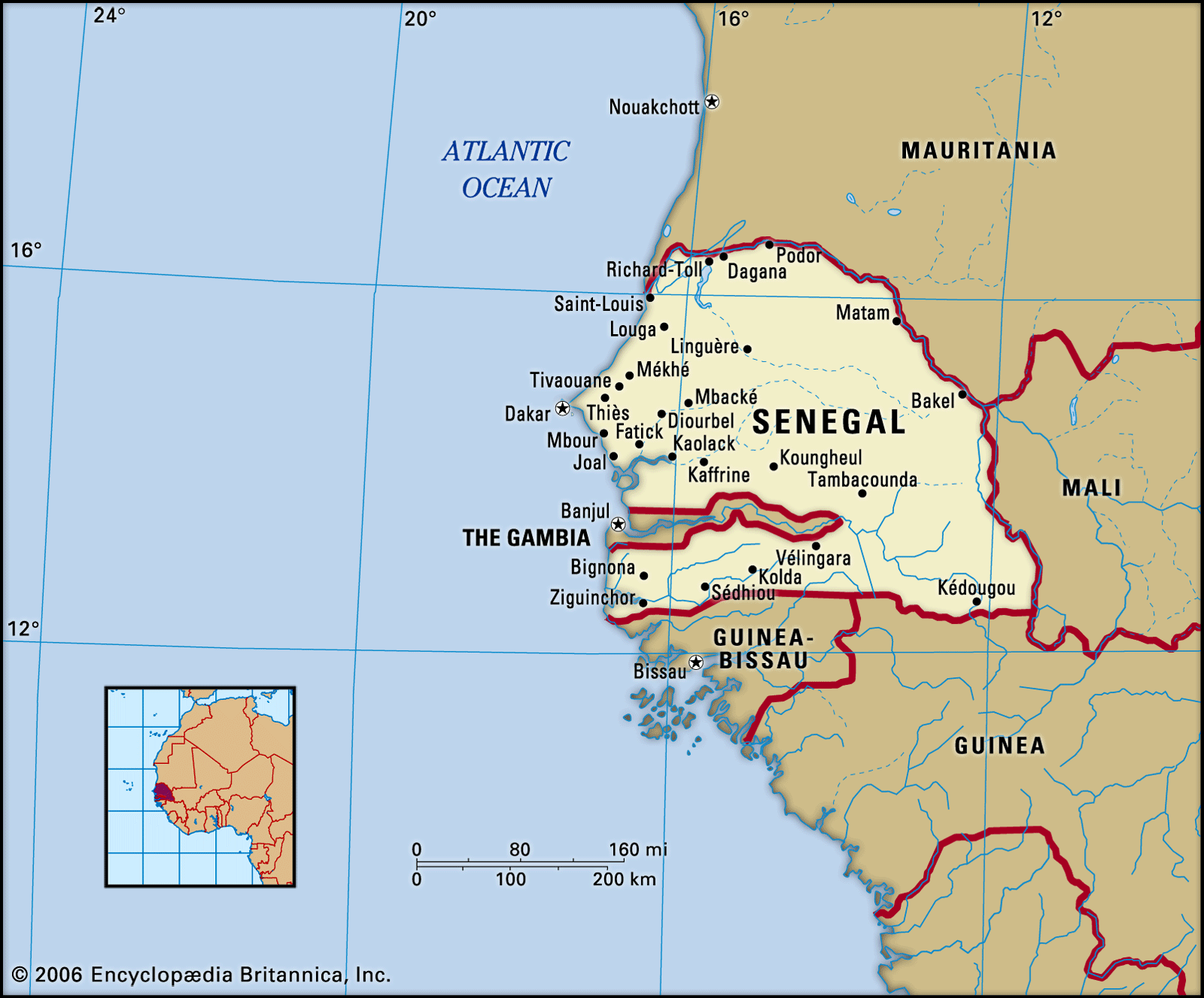BRIEF BACKGROUND
Senegal, a western African country. Senegal is known as the "Gateway to Africa" at the westernmost point of the continent and served by numerous air and maritime travel routes. The country is situated on an ecological frontier where semi-arid grasslands, oceanfront, and tropical rainforest converge; this diverse ecosystem has given Senegal a wide range of plant and animal life. It is from this rich natural heritage that the national symbols of the country have been selected: the baobab tree and the lion. For a long time, the area known today as Senegal was part of the ancient kingdoms of Ghana and an important node on the trans-Saharan caravan routes. It was also an early point of European contact and was opposed in the late 19th century by England, France, Portugal, and the Netherlands before finally falling under French influence. It remained a colony of France until 1960, when it gained its independence under the leadership of the writer and statesman Léopold Senghor, first as part of the short-lived Mali Federation and then as a fully sovereign state. Wolof, members of a highly stratified society whose traditional structure includes a hereditary nobility and a class of musicians and storytellers called griots, are almost two-fifths of Senegal's citizens. Contemporary Senegalese culture, especially its music and other arts, is largely focused on Wolof sources, but it is also evident that other Senegalese groups (including Fulani, Serer, Diola, and Malinke) are influential. Wolof also predominates in matters of state and trade, and over time, this supremacy has fuelled ethnic conflict as less dominant groups struggle for parity with the majority of Wolof. In Senegal, its capital, Dakar, is the most important city. Located on the Cape Verde Peninsula, along the Atlantic coast, this vibrant and attractive metropolis is a popular tourist destination. Although the government has announced plans to move the capital inland eventually, Dakar will remain one of the most important ports in Africa and an economic and cultural center for West Africa as a whole

ECONOMIC OVERVIEW OF THE COUNTRY
The economy of Senegal is powered by mining, construction, tourism, fishing, and agriculture, which, despite the abundant natural resources of iron, zirconia, gas, gold, phosphates, and numerous recent oil discoveries, are the key sources of employment in rural areas. Senegal's economy derives the bulk of its foreign exchange from fish, phosphates, groundnuts, tourism, and services. Senegal's agricultural sector, as one of the dominant parts of the economy, is highly vulnerable to environmental factors, such as changes in rainfall and climate change, and shifts in world commodity prices. French West Africa's former capital is now home to banks and other institutions serving all of Francophone West Africa, and it is the region's shipping and transport center. In Africa, Senegal also has one of the best-developed tourist industries. The economy of Senegal is dependent on foreign assistance. It is a member of the Organization for World Trade. The Senegalese economy has traditionally revolved around a single cash crop, the peanut. The government, however, has worked to diversify both cash crops and subsistence agriculture by expanding into commodities such as cotton, garden produce, and sugarcane as well as by promoting nonagricultural sectors. The government was successful in making fishing, phosphates, and tourism major sources of foreign exchange at the beginning of the 21st century, although the condition of the transportation and power infrastructure placed limits on the amount of expansion possible. Senegalese industries also produce food, textiles, wood products, chemicals, construction materials, machinery, equipment, electricity, and water. However, the industrial sector is currently in crisis due to a lack of energy management. Currently, there are no restrictions on the transfer or repatriation of capital and income earned or investment financed with convertible foreign exchange. Direct U.S. investment in Senegal remains about U.S.$38 million, mainly in petroleum marketing, pharmaceuticals manufacturing, chemicals, and banking. Economic assistance, about U.S.$350 million a year, comes largely from France, the IMF, the World Bank, and the United States. Canada, Italy, Japan, and Germany also assist.
Senegal has well-developed though costly port facilities, a major international airport serving 23 international airlines, and direct and expanding telecommunications links with major world centers.
The service sector contributes to 50,4% to the GDP and employs 55% of the workforce. It benefits from the country's excellent telecommunications infrastructure, which fosters investment in teleservices and the Internet. This sector has been expanding steadily. Tourism has also been growing, particularly among European travelers. The exploitation of mineral resources such as gold, petroleum, and natural gas also diversified the economy. Between 2014 and 2018, Senegal's economic growth was among the fastest in Africa, staying above 6 percent annually. In 2019, the rise in GDP was 5.3 percent, down from 6.3 percent in 2017. The services sector continues to be the largest contributor to GDP growth, while investment (+12.5%) and exports (+7.2%) were the strongest drivers of growth on the demand side. The COVID-19 pandemic has improved Senegal's economic outlook dramatically since early 2020. The development has slowed considerably to a projected 1.3% in 2020, with services (such as tourism and transport) and exports being especially hard hit. With containment measures and a comprehensive economic stimulus plan (PRES) to safeguard lives and livelihoods, Senegal has replied. However, there are problems with minimal fiscal reserves and safety nets, a vulnerable healthcare system, and a broad informal sector. Economic recovery will likely be gradual, driven by a robust return of private consumption and investment. Reforms envisioned under the Senegal Emerging Plan (PSE) need to be deepened for growth to resume its pre-pandemic trajectory. Significant crowding in of private investment is central to increasing Senegal’s productive capacity and supporting export growth. Services remain the main contributor to GDP and the primary sector (agriculture, in particular) the most dynamic growth driver. Oil and gas developments have been delayed due to COVID-19 and are expected to contribute to revenues and exports only around 2025.